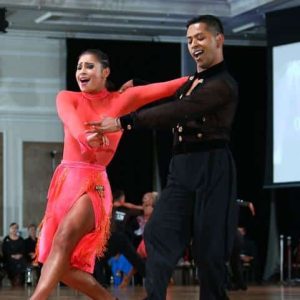Dance has been a fundamental part of human expression and social interaction for centuries. Among the many dance forms that have evolved over time, ballroom dance stands out as a captivating and sophisticated style that has captured the hearts of millions around the world. Our expert dance instructors at Fred Astaire Dance Studios – Valparaiso honor this time-old tradition and bring the history to life. In this blog, we will delve into the rich history and origins of ballroom dance, tracing its roots from social gatherings to its development as a competitive sport and mesmerizing performance art.
The Birth of Ballroom Dance: A Social Phenomenon
Ballroom dance can trace its origins back to the grand ballrooms and royal courts of the Renaissance era in Europe. During this time, dance was not only a form of entertainment but also a way for the elite to display their refinement and social status. The dances of this period were often structured and choreographed, with precise steps and patterns, making them the predecessors of the ballroom dances we know today.
One of the earliest documented ballroom dances is the Minuet, which originated in France in the late 17th century. The Minuet was characterized by its graceful and elegant movements and was performed in a structured and formal setting. It set the stage for the development of other ballroom dance styles.
The Influence of Social Dancing
While ballroom dance was thriving in aristocratic circles, social dances were gaining popularity among the common people. These social dances provided an opportunity for individuals from various backgrounds to come together and enjoy the pleasure of dancing.
In the 19th century, social dance was greatly influenced by the waltz, a dance that broke with tradition by allowing couples to dance closely in an embrace. The waltz’s rise in popularity marked a significant shift in the way people danced, moving away from the formal and structured dances of the past towards a more intimate and romantic style.
The Emergence of Competitive Ballroom Dance
As the 20th century dawned, ballroom dance underwent a transformation, evolving from a purely social activity into a competitive sport. Competitive ballroom dance began to take shape in England, where dance competitions became a staple of society events and were even broadcast on radio and television.
Two distinct styles of ballroom dance emerged during this period: Standard and Latin. Standard dances, such as the waltz and foxtrot, focused on elegance, precision, and graceful movements. In contrast, Latin dances like the cha-cha and samba emphasized rhythm, passion, and energetic footwork. These two categories formed the foundation of modern competitive ballroom dance.
The Influence of Hollywood and Popular Culture
During the mid-20th century, ballroom dance experienced a surge in popularity thanks to the influence of Hollywood and popular culture. Iconic dance films like “Fred Astaire and Ginger Rogers” and “Dirty Dancing” brought ballroom dance into the mainstream, inspiring countless individuals to take up dancing as a hobby and a form of artistic expression.
The advent of television dance shows further fueled the ballroom dance craze, with programs like “Dancing with the Stars” showcasing celebrities and professional dancers competing in ballroom dance styles. These shows not only entertained viewers but also introduced them to the various forms and styles of ballroom dance.
Ballroom Dance as a Performance Art
While ballroom dance has its roots in social gatherings and competition, it has also evolved into a captivating performance art. Dancers trained in ballroom techniques often perform in exhibitions and shows, captivating audiences with their intricate choreography, dazzling costumes, and passionate interpretations of music.
Professional ballroom dancers, like those in the renowned Blackpool Dance Festival, demonstrate the pinnacle of technical skill and artistic expression in this genre. They blend elements of traditional ballroom dance with innovative choreography to create breathtaking performances that leave spectators in awe.
A Dance Form with a Rich History and Bright Future
Ballroom dance has come a long way from its origins in the grand ballrooms of Europe. It has evolved from a formal and structured social dance into a dynamic and diverse art form, encompassing both competitive sport and breathtaking performance. Its enduring popularity is a testament to its ability to captivate and inspire people of all ages and backgrounds. As we continue to explore the history and origins of dance, we must remember that ballroom dance is not merely a series of steps and patterns; it is a celebration of human connection, expression, and the joy of movement. Whether you’re dancing in a grand ballroom, on a competitive stage, or in your living room, ballroom dance will continue to enchant and unite people for generations to come. Come explore the rich world of ballroom dance at Fred Astaire Dance Studios in Valparaiso!

